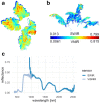Measuring crops in 3D: using geometry for plant phenotyping
- PMID: 31497064
- PMCID: PMC6719375
- DOI: 10.1186/s13007-019-0490-0
Measuring crops in 3D: using geometry for plant phenotyping
Abstract
Using 3D sensing for plant phenotyping has risen within the last years. This review provides an overview on 3D traits for the demands of plant phenotyping considering different measuring techniques, derived traits and use-cases of biological applications. A comparison between a high resolution 3D measuring device and an established measuring tool, the leaf meter, is shown to categorize the possible measurement accuracy. Furthermore, different measuring techniques such as laser triangulation, structure from motion, time-of-flight, terrestrial laser scanning or structured light approaches enable the assessment of plant traits such as leaf width and length, plant size, volume and development on plant and organ level. The introduced traits were shown with respect to the measured plant types, the used measuring technique and the link to their biological use case. These were trait and growth analysis for measurements over time as well as more complex investigation on water budget, drought responses and QTL (quantitative trait loci) analysis. The used processing pipelines were generalized in a 3D point cloud processing workflow showing the single processing steps to derive plant parameters on plant level, on organ level using machine learning or over time using time series measurements. Finally the next step in plant sensing, the fusion of different sensor types namely 3D and spectral measurements is introduced by an example on sugar beet. This multi-dimensional plant model is the key to model the influence of geometry on radiometric measurements and to correct it. This publication depicts the state of the art for 3D measuring of plant traits as they were used in plant phenotyping regarding how the data is acquired, how this data is processed and what kind of traits is measured at the single plant, the miniplot, the experimental field and the open field scale. Future research will focus on highly resolved point clouds on the experimental and field scale as well as on the automated trait extraction of organ traits to track organ development at these scales.
Keywords: 3D plant scanning; Parameterization; Plant model; Plant traits; Point cloud.
Conflict of interest statement
Competing interestsThe author declares that he has no competing interests.
Figures





Similar articles
-
Registration of spatio-temporal point clouds of plants for phenotyping.PLoS One. 2021 Feb 25;16(2):e0247243. doi: 10.1371/journal.pone.0247243. eCollection 2021. PLoS One. 2021. PMID: 33630896 Free PMC article.
-
An Accurate Skeleton Extraction Approach From 3D Point Clouds of Maize Plants.Front Plant Sci. 2019 Mar 7;10:248. doi: 10.3389/fpls.2019.00248. eCollection 2019. Front Plant Sci. 2019. PMID: 30899271 Free PMC article.
-
Low-cost 3D systems: suitable tools for plant phenotyping.Sensors (Basel). 2014 Feb 14;14(2):3001-18. doi: 10.3390/s140203001. Sensors (Basel). 2014. PMID: 24534920 Free PMC article.
-
Technical workflows for hyperspectral plant image assessment and processing on the greenhouse and laboratory scale.Gigascience. 2020 Aug 1;9(8):giaa090. doi: 10.1093/gigascience/giaa090. Gigascience. 2020. PMID: 32815537 Free PMC article. Review.
-
How to make sense of 3D representations for plant phenotyping: a compendium of processing and analysis techniques.Plant Methods. 2023 Jun 23;19(1):60. doi: 10.1186/s13007-023-01031-z. Plant Methods. 2023. PMID: 37353846 Free PMC article. Review.
Cited by
-
Digital plant pathology: a foundation and guide to modern agriculture.J Plant Dis Prot (2006). 2022;129(3):457-468. doi: 10.1007/s41348-022-00600-z. Epub 2022 Apr 28. J Plant Dis Prot (2006). 2022. PMID: 35502325 Free PMC article.
-
Cereal grain 3D point cloud analysis method for shape extraction and filled/unfilled grain identification based on structured light imaging.Sci Rep. 2022 Feb 24;12(1):3145. doi: 10.1038/s41598-022-07221-4. Sci Rep. 2022. PMID: 35210561 Free PMC article.
-
Proximal and remote sensing in plant phenomics: 20 years of progress, challenges, and perspectives.Plant Commun. 2022 Nov 14;3(6):100344. doi: 10.1016/j.xplc.2022.100344. Epub 2022 Jun 2. Plant Commun. 2022. PMID: 35655429 Free PMC article. Review.
-
Ontogeny and Anatomy of the Dimorphic Pitchers of Nepenthes rafflesiana Jack.Plants (Basel). 2020 Nov 18;9(11):1603. doi: 10.3390/plants9111603. Plants (Basel). 2020. PMID: 33218142 Free PMC article.
-
Accurate LAI estimation of soybean plants in the field using deep learning and clustering algorithms.Front Plant Sci. 2025 Jan 22;15:1501612. doi: 10.3389/fpls.2024.1501612. eCollection 2024. Front Plant Sci. 2025. PMID: 39911650 Free PMC article.
References
-
- Walklate PJ. A laserscanning instrument for geometry measuring crop. Science. 1989;46:275–284.
-
- Omasa K, Hosoi F, Konishi A. 3D lidar imaging for detecting and understanding plant responses and canopy structure. J Exp Bot. 2007;58(4):881–98. - PubMed
-
- Paulus S, Schumann H, Leon J, Kuhlmann H. A high precision laser scanning system for capturing 3D plant architecture and analysing growth of cereal plants. Biosyst Eng. 2014;121:1–11.
-
- Godin C. Representing and encoding plant architecture: a review. Ann For Sci. 2000;57(5):413–438.
Publication types
LinkOut - more resources
Full Text Sources
Other Literature Sources

